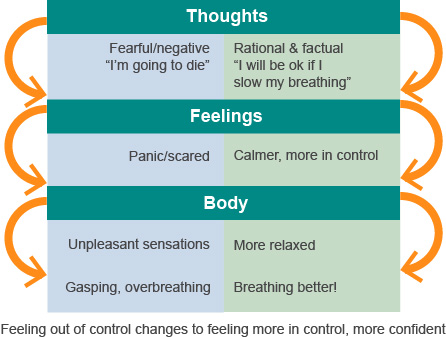The panic & breathlessness spiral
Breathlessness can be a common trigger for anxious thoughts about our breathing, this can lead us feel to feel more scared, activating our ‘fight or flight response’ and create more physical symptoms. By challenging our automatic negative thoughts and slowing our breathing we can reduce the impact of anxiety on our breathing.

- View text alternative
-
Thoughts: Fearful/negative – rational & factual: “I’m going to die” – “I will be ok if I slow my breathing”
Feelings: Panic/scared – calmer, more in control
Body: Unpleasant sensations – more relaxed
Feeling out of control changes to feeling more in control, more confident: Gasping, overbreathing – Breathing better!
For people attending the pulmonary rehabilitation programme, a major focus is obviously on breathing – on how changes in our breathing make us feel and also how we feel affects our breathing.
Eg if they have felt breathless and have the automatic thoughts eg ‘I can’t cope with this, I think I am going to suffocate’…this frightening thought triggers off the fear response increased adrenalin etc which produces more physical symptoms, more breathlessness and so increases our feelings of being out of control.
Think of what happens when they challenge the automatic thoughts related to breathlessness eg – I know that this happens, I know if I sit and wait until it passes, do my breathing control, then my breathing will return to normal. The person may still feel uncomfortable, but they don’t get the same fear response, their body returns to normal sooner and they are able to gain control of their breathing again.
Trigger is the same – breathlessness – what is different is their response to the breathlessness, what they were thinking about it and what they did, can have a direct influence on the outcome.
The aim is not to try and avoid breathlessness at all costs – but to become more aware of our breathing, become aware of when feeling out of breath is becoming out of control and be able to pace self accordingly.




